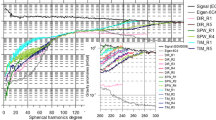Abstract
Gravity disturbances (or free-air anomalies), the Marussi tensor, invariants of the gravity field, and other functionals and functions (here called aspects) of the geopotential, as represented by recent global gravitational field models, are computed for Ghawar, Saudi Arabia, (Al-Anazi, 2007) (Al-Almazi, 2007) and for surrounding areas. With the free-air gravity anomalies, derived from the Earth Gravitational Field Model 2008 (EGM 2008) or European Improved Gravity model of the Earth by New techniques (EIGEN)-6C3 gravity models (based on satellite as well as terrestrial data), we can see features well known to geologists, geophysicists, geomorphologists, and others. Resolution with the global gravitational models is, however, lower than with terrestrial data only, but our “view” is global. With the invariants, strike angles, and virtual deformations, we can find more interesting features (than with the gravity anomalies themselves). We can see analogies between places with oil deposits in the area of the Caspian Sea, Ghawar in Saudi Arabia, and other localities nearby. It is evident that the only “gravity signal” (the aspects) cannot decide about possible deposits of any mineral or oil but—as is known on a local scales—can be a useful tool, which—in conjunction with other data and experience of specialists—may lead to some discoveries. Several interesting places are indicated by the strike angles and virtual deformations at the Persian and Oman Gulfs, Saudi Arabia, the United Arab Emirates (UAE) and the Red Sea.





Similar content being viewed by others
References
Al-Anazi BD (2007) What you know about the Ghawaroil field, Saudi Arabia? CSEG Recorder, April, pp 40–43
Beiki M, Pedersen LB (2010) Eigenvector analysis of gravity gradient tensor to locate geologicbodies. Geophysics 75(6):137–149. doi:10.1190/1.3484098
Dickinson JL, Brewster JR, Robinson JW, Murphy CA (2009) Imaging techniques for full tensor gravity gradiometry data, 11th SAGA BiennalTechn. Meeting & Exhib., Swaziland, September, pp 84–88
Förste C, Bruinsma S, Abrykosov O, Flechtner F, Dahle C, Neumayer K H, Barthelmes F, König R, Marty J C, Lemoine J M, Biancale R (2013) EIGEN-6C3—the newest high resolution global combined gravity field model based on the 4th releaseofthe GOCE direct approach, BookofAbstracts, The IAG ScientificAssembly 2013, 150th Anniv. IAG (Potsdam 2013)
Floberghagen R, Fehringer M, Lamarre D, Muzi D, Frommknecht B, Steiger Ch, Piñeiro J, da Costa A (2011) Mission design, operation and exploitation of the gravity field and steady-state ocean circulation explorer mission. J Geodesy 85:749–758. http://rd.springer.com/article/10.1007/s00190-011-0498-3; http://dx.doi.org/10.1007/s00190-012-0541-z
Kalvoda J, Klokočník J, Kostelecký J (2010) Regional correlation of the Earth Gravitational Model 2008 with morphogenetic patterns of the Nepal Himalaya. Acta Univ Carol Geographica XLV(2):53–78, Prague
Kalvoda J, Klokočník J, Kostelecký J, Bezděk A (2013) Mass distribution of Earth landforms determined by aspects of the geopotential as computed from the global gravity field model EGM 2008. AUC Geographica 48(2):17–25
Klokočník J, Kostelecký J, Pešek I, Novák P, Wagner CA, Sebera J (2010) Candidates formultiple impact craters?: Popigai and Chicxulub as seen by the Global High Resolution Gravitational Field Model EGM08. Solid Earth EGU 1:71–83. doi:10.5194/se-1-71
Klokočník J, Kostelecký J, Kalvoda J, Sebera J, Bezděk A (2012) Towards a system of datasystems in geoscience: Marussi tensor and invariants of the Earth Gravity Field from recent global gravity models EGM 2008 and EIGEN 6C based on satellite (GRACE or GOCE) and terrestrial data – poster, the Japan Geoscience Union Meeting 2012, May, Makuhari, Chiba, Tokyo, Japan
Klokočník J, Kalvoda J, Kostelecký J, Bezděk A (2013) Gravity disturbancies, Marussi tensor, invariants and other derivates of the geopotential represented by Global Gravity Field Model EGM 2008 and suggested for geo-applications in various regions of the Earth, ESA Living Planet Symposium, September, Edinburgh, Scotland, poster 2–P–228
Mataragio J, Kieley J (2009) Application of full tensor gradient invariants in detection of intrusion-hostedsulphide mineralization: implications for deposition mechanisms. Min Geosci EAGE 1st break 27:95–98
Murphy CA, Dickinson JL (2009) Exploring exploration play models with FTG gravity data, 11th SAGA Biennal Techn. Meeting & Exhib., September, Swaziland, pp 89–91
Pavlis NK, Holmes SA, Kenyon SC, Factor JK (2008a) EGM2008: an overview of its development and evaluation, National Geospatial-Intelligence Agency, USA, presented at the interntl.conf.Gravity, Geoid and Earth Observation 2008, 23rd–27th June, Chania, Crete, Greece
Pavlis NK, Holmes SA, Kenyon SC, Factor J K (2008b) An earth gravitational model to degree 2160: EGM2008, EGU General Assembly 2008, 13–18th April, Vienna, Austria
Pavlis NK, Holmes SA, Kenyon SC, Factor J K (2012) The development and evaluation of the Earth Gravitational Model 2008 (EGM2008). J Geophys Res 17:B04406. doi:10.1029/2011JB008916
Pedersen BD, Rasmussen TM (1990) Thegradient tensor of potential field anomalies: some implications on data collection and data processing of maps. Geophysics 55(12):1558–1566
Pollastro RM, Persits FM, Steinshouer D W (1997) Maps showing geology, oil and gas fields and geologic provinces of Iran, version 1.0, Open-File Report 97/470G, USGS Central Region Energy Resources Team
Saad AH (2006) Understanding gravity gradients—a tutorial, the meter reader, The Leading Edge, August, pp 942–950
Acknowledgments
We thank very much the anonymous reviewer for his helpful and inspiring review. Our work has kindly been supported by grants from the Grant Agency of Czech Republic no. 13-36843S (J. Klokočník) and by the European Regional Development Fund (ERDF), project “NTIS—New Technologies for Information Society,” European Centre of Excellence,
NTIS-CZ.1.05/1.1.00/02.0090 (J. Kostelecký).
Author information
Authors and Affiliations
Corresponding author
Rights and permissions
About this article
Cite this article
Klokočník, J., Kostelecký, J. Gravity signal at Ghawar, Saudi Arabia, from the global gravitational field model EGM 2008 and similarities around. Arab J Geosci 8, 3515–3522 (2015). https://doi.org/10.1007/s12517-014-1491-y
Received:
Accepted:
Published:
Issue Date:
DOI: https://doi.org/10.1007/s12517-014-1491-y




